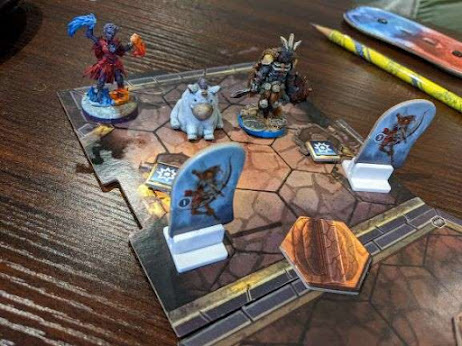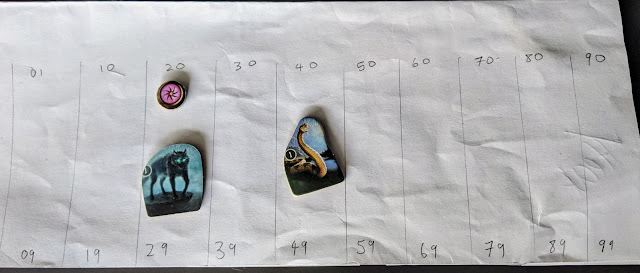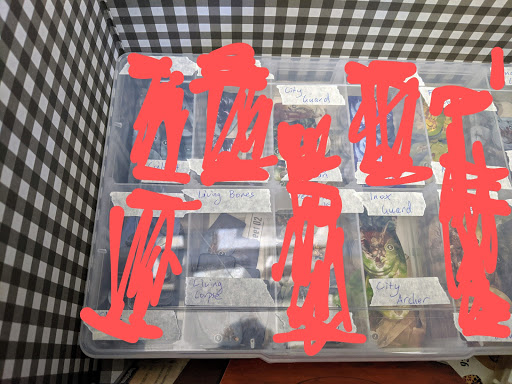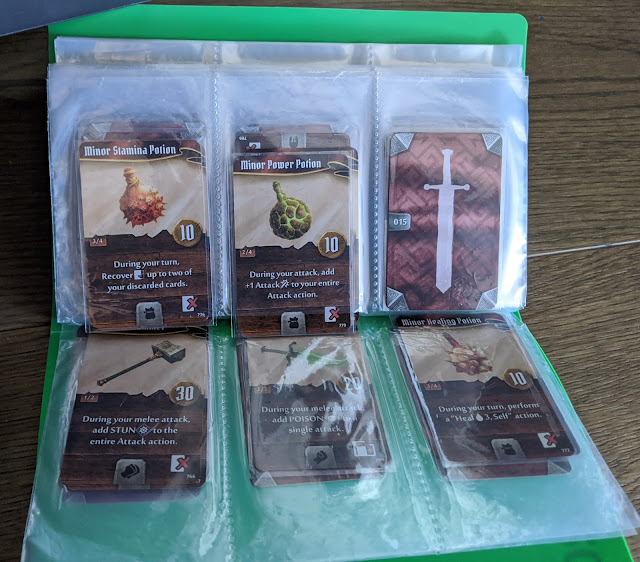Gloomhaven - Faster setup guide
We're going to cover something different this time. How to setup your game faster.
There's dedicated organizers you can buy that will make your life easier, such as this. However, you can get by with much cheaper and more accessible items.
 |
| A Spellweaver, her Chubby Unicorn summon and a Brute face off against some bandits. |
City and Event cards
At the beginning of your campaign, you only need cards 1-30 for the Road and City events respectively. All the other City and Event cards can be put aside.
I recommend getting opaque sleeves such as these. These prevent you from seeing the results side of the event by accident until your party has committed to either Option A or B. I recommend you sleeve only the cards in the active City and Road event decks (e.g events 1-30 at the beginning). When you go to setup the game, you can easily differentiate between the cards that belong in the event deck and those that have yet to be shuffled in.
Monsters, Tokens, Coins, Traps, Doors, Obstacles and other special Hexes.
Invest in a compartment or tackle box. You can get these from department stores and/or fishing equipment stores. These run considerably cheaper than the dedicated organizers, and will make your life easy. Here is a link to an example from Target and one from Bunnings Australia. However, you can find these almost anywhere.
 |
| A tackle box for fishing, also useful for carrying Gloomhaven tokens. |
Once you have a few Compartment boxes, I recommend you label them for two reasons:
- When you put the pieces back, you know where they go.
- Some pieces are double sided, e.g the Lava / Fountain tile. A label can help you figure out which compartment to find it in if the side is for example, facing downward.
It doesn't need to be elegant, it just needs to work. Here's a photo of mine, it's just masking tape + a pen. My handwriting isn't fantastic but it works.
It works for Monsters too. I covered up the names of some of the monsters to avoid minor spoilers.
Traps, Doors and Coins are going to be in nearly every scenario. So make sure to keep those handy!
Apps
Apps are great for streamlining the bookkeeping in combat. They can remove the need to use monster cards and damage markers entirely. Gloomhaven Helper is the recommended App for keeping track of combat. It speeds up the setup time immensely if you have the technology at home to use it. I recommend casting the App to a larger TV screen if you can.
Initiative tracking
If you are unable to or don't want to use Apps to manage your combat, I recommend creating an initiative tracker, as it's one of the trickiest things to keep tabs on during combat. You can do this cheaply with a pen and paper.
 |
| A crude but effective initiative tracker |
The initiative tracker above takes a minute to create and players simply need to put their token where their relative initiative sits. It saves the party from having to ask "Who's after initiative 21 again?".
Storing tiles
Rather than trying to play Tetris with the map tiles, store them in Alphabetical order. We are optimizing for setup time, so the faster it is to locate your tiles, the better.
Here I get a large folder and store the tiles in Alphabetical order. It's not pretty, but it works and lets you find tiles quickly. Any accordion folder could work here.
Item store
How should you track the items available for players to buy?
Option 1: Buy a business card holder. Available items flipped front first, unavailable items flipped with their back first.
Option 2: Even simpler is just throw the available items in a separate box. You can use an empty deck box, or anything of appropriate size lying around. Ultra pro deck box Example.
Then as new item designs become available, you throw them into the box so everyone knows what they can buy.
Player cards and items
What about storing player cards and their modifier decks, personal quests and items between games?
This redditor uses more boxes.
I personally use a more primitive method and simply load a sandwich bag with all the cards and pieces relevant to the player. During setup I simply toss each player their corresponding sandwich bag and they start unpacking. It's fast, cheap and does the job.
Fast setup means more games, and more Gloomhaven means more time to experiment and learn new powerful combinations.








Great advice, thanks!
ReplyDeleteMy solution to avoid spending too much time on setup is to decide at the end of our gaming session what scenarios we'll be playing next, or what general direction we intend to take story-wise.
As the game owner, I then take some time to prepare the 2-3 scenarios we intend on playing during our next session and put all the relevant material (map tiles, obstacles, traps, monsters, etc.) in a large zip-lock bag, one per scenario. Then all we have to do during the session is take out the bag and play!
Another perk of this is that only I will have seen what the scenario looks like (I don't read them, I only have a cursory look to know what I need to prepare), so it's mostly a surprise for the two other players. We tend to keep prior knowledge to a bare minimum and go blind to increase the difficulty rather than boosting monster stats, etc. If we have to redo a failed scenario, we then can take into account what we've learnt during our failed attempt to change our card selection.